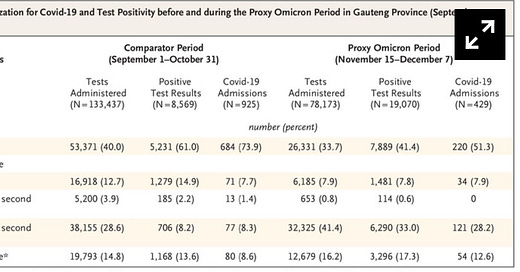Regular readers probably remember this article where I questioned the South Africa Discovery data showing the vaccine is 33% effective against omicron and 70% effective against hospitalizations. The basis for knowing that number was a lie was due to the test negative design the study used.
As I said, the trend is for researchers to overestimate vaccine effectiveness when using a test negative design. While I want to do a full article on this design type in the future, the answer for what went wrong in South Africa is simple: the vaccinated and the unvaccinated have different health seeking behaviors. The test negative design is supposed to control for that by assuming the people that get tested have the *same* health seeking behavior. That’s not anywhere near true.
An anecdote: I know a vaccinated person that had the sniffles who took at least 5 tests over the holidays as did his whole family. None of them had the virus. I took 1 because I am forced to in order to pay rent. Before omicron, when the vaccinated fear was low, I had to test to work and my vaccinated colleague did not get tested at all. In no cases do we have the same or even similar health seeking behavior. This observation is broadly true among the vaccinated and unvaccinated. They test and test often because they are afraid, we test either when we have to or because we legitimately have symptoms (and are more likely to accept the results of the first test). If we were afraid, we would get vaccinated.
Anyways, the first data from South Africa is trickling in and it’s bad. Real bad. This study is from Gauteng province, which is about 31.2% vaccinated as of TODAY (41.94% in adults). The recheck tells me over 1 million doses have been given out in the province since this study began, presumably at least some of those were first doses. But using today’s vaccination rate, VE when not using a test negative design looks to have been -212%1 for omicron and -109% against hospitalizations for omicron. Even worse, in the pre-Omicron period VE was -40%2 and just 22% against hospitalizations.
Now, one might say that the different health seeking behavior applies both ways… but I am sure that these are huge overestimates of VE in either case. I am using today’s vaccination rate for both the omicron and pre-omicron period only because I could not find reliable data on Gauteng's vaccination rates over time3. Frankly, these numbers are brutal for the vaccinated. Yikes.
7889 unvaccinated cases, 11181 vaccinated cases assuming 4,940,213 have their first dose and 220 unvaccinated hospitalizations v. 209 vaccinated hospitalizations under the same assumption
5231 unvaccinated v. 3338 vaccinated cases, 684 unvaccinated v. 241 vaccinated hospitalizations under the above assumption
If someone can find more reliable numbers, please let me know and I will revise the article!





"The hospitalizations are in younger people"
"They are mild"
"The admissions are co-incidental"
All of those headlines made me nervous because they'd just started jabbing teens, a little discussed fact. These figures are not reassuring at all. Unless we do autopsies of people that died, we'll never know what the excess deaths were from and I have no faith in the Covid-19 categorizations because they are easily manipulated to suit a specific narrative.
How are you calculating VE here?